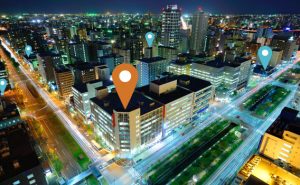Businesses have reopened and while much has returned to normalcy as we begin to move into the post-COVID-19 world, some aspects of life have shifted – including people’s habits. For example, we’ve seen the so-called California exodus while cities in Arizona and Texas (among others) have witnessed an influx of residents.
It’s not just where people live that’s changed. The way they shop has too. According to the U.S. Department of Commerce Retail Indicator Division, eCommerce grew 14.2% in 2021 over the previous year. Companies can’t go back to their pre-pandemic methods for site location and other business expansion because of these changes – and others, such as those in the competitive landscape.
In today’s “new normal,” these decisions must be made in light of the new baseline. The use of location intelligence, specifically human mobility data – which focuses on how people move about in the world – can make navigating these changes much easier.
Demographic and location changes
Long before the pandemic, population hubs were shifting. However, the last two years have seen new migration patterns emerge. People are migrating from tightly packed metropolitan areas to less crowded neighborhoods in another county or state, for example. Based on percentage of population growth between 2010 and 2020, Texas now has 9 of the top 15 fastest-growing cities in the United States. In addition, compared to pre-March 2020, California had a 12% rise in people leaving the state.
We’ve witnessed shifts in foot traffic around key hubs, in addition to people migrating to new areas. For example, many urban centers are experiencing less traffic than they used to on weekdays as more individuals work remotely at least part of the week. However, this varies greatly by region. For instance, foot traffic in some portions of downtown Cincinnati has declined by 59% since 2019, whereas foot traffic in downtown Buffalo has increased to 84% of 2019 levels, according to our data.
These are the key indicators that business decision-makers need to have at their disposal when deciding where to open their next store, for example.
Location intelligence-based recon
When it’s time to make business decisions, knowing how many people are visiting specific sites, when they’re visiting, and where they’re heading next can be really useful. What if you could get beyond the basics and collect data on demographic profiles, as well: Is this a group of men? Women? How much money do they make? Are they only there to do their job? Do they live nearby, or are they visitors?
What’s key is having the ability to aggregate data on not just the traffic volume but also the demographics, and then comparing it to pre-COVID data. For example, a company’s real estate division could prefer to concentrate on a specific set of data, such as areas experiencing rapid population growth or areas with gaps in the local market that offer new opportunities.
You might use migration patterns datasets to track census tract growth month by month for a certain location. If you wanted to expand your firm in Illinois, for instance, you would look for areas where the population is growing. The income level of newcomers is a second factor that could also indicate the locations that might be right for a new store. But you first need to figure out who your local competitors are and how business is going for them.
You can study peak visitation and foot traffic patterns surrounding competitors’ stores using retail data analytics and mobile location data. This will assist you in making informed decisions regarding where your store should be located and how it should be positioned.
You would now look at the distance consumers travel to competitor stores to detect market gaps. Maybe you’ve discovered that the majority of visitors arrive from within five miles of your competitor’s business, but around a third come from further afield. It might therefore make the most sense to locate a retail outlet closer to those farther-away customers.
This is the type of detail that location data contains, and though it isn’t the only set of considerations that go into site selection, it can and should be an important part of making business decisions of this kind. In fact, a potential customer’s ability to locate a new retail location on a map is one of the most important determinants in its success. Location data can help a shop owner figure out where the best places are to open a store.
Greater accessibility, new opportunities
Location data holds many advantages, but it hasn’t always been so readily available – and its accuracy hasn’t always been reliable. Furthermore, working with datasets like these has typically necessitated an internal data team, which not all companies have.
Fortunately, data of this kind is becoming increasingly democratized and available, so you don’t have to hire an in-house data science team. Furthermore, businesses have hastened their digital transition; major organizations’ data-working capabilities are now quickly improving.
The intel retailers need
When trying to choose a new retail site, there’s more involved than real estate transactions. The decision-making process for choosing a new site involves a plethora of retail store data. Determining the potential for store foot traffic is crucial to enticing potential customers to any new location. Using location data to help with the site selection process is critical in metropolitan trade areas, where both foot traffic from potential customers and retail competitor density are typically high.
Decisions this important need current, post-COVID data to guide them. Because human mobility patterns have changed, getting the most recent data is critical. Examining population statistics, movement and income patterns, and neighborhood recovery indicators are all part of the process of opening new businesses in new areas. To swiftly and reliably inform the process of retail site selection, best practices advocate using location data to examine potential store sites.








